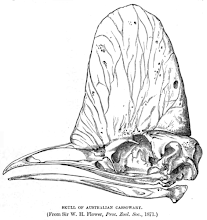 the shoebill lives in egypt and is particularly bizarre looking--when i first saw a picture, i thought it was a muppet.
the shoebill lives in egypt and is particularly bizarre looking--when i first saw a picture, i thought it was a muppet.interestingly, shoebills could be the missing link between storks and pelicans! wikipedia told me that one, so i don't know if it's true. i can see it, though-- the neck and head positioning look pretty stork-like, but lookit that bill! go-lly, i would say that the shape is reminiscent of a pelican. a lot of fish eating birds rely on serrations on the bill to secure the fish, but shoebills and pelicans just rely on having REALLY BIG MOUTHS!
despite their huge size, shoebills can [and do] fly.

the slotting on the primaries promotes gradual lift, which is great for big ole soaring birds who don't want to flap too much. what the slots do is direct air over the wing surface, which creates favorable pressures both above and below the wing. if the bird wants lift, it changes the positioning of the primary feathers so that airflow is directed under the wing, creating higher pressure from below and therefore lift. usually, the slots work in tandem with a structural feature called camber.
camber is the teardrop shape you see when you look down the length of the wing.


the higher angle of camber, the higher severity of lift for the bird. i think i'll talk about thrust at a later date.
physics in nature is one of my favorite things to think about; physics describes the laws that govern nature, and biota evolve to fit their mold. what's REALLY COOL and MY FAVORITE THING EVER is that living things are just little balls of energy[/mass/energy]that manifest in endlessly different forms. the better an organism follows the laws of physics, the more likely it is to survive and reproduce. in the words of Biology, "form follows function."


that video is fucking amazing.
ReplyDelete